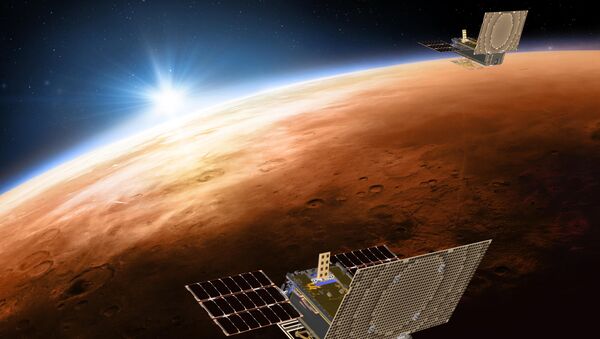NASA’s first robotic InSight lander designated to study Mars has discovered some odd magnetic pulsations and some evidence that there could be a global reservoir of liquid water beneath the Red Planet’s surface, as revealed this week during a joint meeting of the European Planetary Science Congress and the American Astronomical Society, National Geographic reports.
While Mars’s global magnetic field collapsed around 4 billion years ago, turning the planet into a cold desert with drained water reservoirs, InSight’s magnetometer has picked up some measurement of existing magnetic signals coming from rocks near the lander, which are stable and much stronger than was expected, and mysteriously occur at Mars’s midnight.
So far scientists have speculated that these magnetic pulsations could be explained by Mars’s weak magnetic bubble getting compressed by solar wind’s magnetic field and coming into contact with the spot detected by the lander at the exact time every day, but the accuracy of magnetic pulsations and absence of tests to prove this hypothesis has created a mysterious puzzle for researchers.
“We’re getting an insight into Mars’s magnetic history in a way we’ve never had before", says Paul Byrne, a planetary geologist at North Carolina State University.
The InSight magnometer’s tests have also discovered a four-kilometre-thick electrically conductive layer beneath Mars’s surface, around 100 km deep that can be an aquifer of water with dissolved solids, similarly to Earth’s groundwater. Given the strong evidence of the presence of ground ice on Mars, there is also a possibility that there are large subterranean reservoirs of water underneath the planet’s surface.
Dave Brain, a researcher of atmospheric and space physics from the University of Colorado, argues that while InSight can only dig as deep as 5 metres below Mars’s surface, it remains impossible to prove the presence of a potential oasis, but other causes for the signals coming from the electrically conductive layer have to be ruled out.
The InSight mission was launched in May 2018, with the Mars lander reaching the planet in November after 205 days in space. It is the first robotic explorer in outer space to study a planet’s evolution through a thorough investigation of its upper crust, measurement of strength and direction of its magnetic field, as well as the recording of any potential alien quakes.

